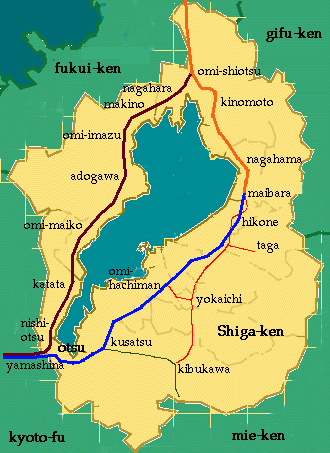where you are:SSG Home/the guide/transportation/regular trains
|
| Compared to many nations, the public transportation system in Japan is very advanced. Japanese people frequently use public transportation because it is often far more convenient and inexpensive than using one's own automobile. Airports, as well as train, bus and subway stations, can be found throughout the country. The train is likely the most popular form of transportation in Japan. |
|
| THE TRAIN SYSTEM OF SHIGA |

When in doubt ... ask!
Is this a local/express train?
Kono densha wa futsu/shinkaisoku desu ka.
Does this train stop at... station?
Kono densha wa ... eki ni tomarimasu ka.
How much does it cost to go to ... station?
... eki made wa ikura desu ka.
more... |
|
There are three train companies in Shiga Prefecture: Japan Rail (JR), Omi Tetsudo and Keihan Railways. The Japan Rail is the national train company, while Omi Tetsudo and Keihan are private. |
 |
JR Biwako Line |
 |
JR Kosei Line |
 |
JR Kusatsu Line |
 |
JR Hokuriku Line |
 |
Omi Tetsudo Line |
 |
Keihan Railway
*not shown on this map |
|
| JAPAN RAIL |
The Japan Rail consists of four major lines: the Biwako Line, Kosei Line, Kusatsu Line and Hokuriku Line. While Shiga Prefecture is not large, Lake Biwa's location in the center of the prefecture can turn a trip between two cities a short distance from each other into a sometimes lengthy journey if they are on opposite sides of the lake.
Types of Trains
Not including the bullet train, there are two types of Japan Rail trains in Shiga:
- Local Trains (futsu
 ) )
- Limited Express (shinkaisoku
 ) )
These are two words that one should learn immediately. Also, it is helpful to learn the kanji for these words. Futsu trains stop at every station. Therefore, you will never find that you cannot get off at your stop if you ride this train. However, depending on the length of your journey, it could take significantly longer.
Shinkaisoku trains stop at only major stations, and are therefore, much quicker. However, if you want to go to a futsu train stop, you must either ride a futsu train or transfer to a futsu stop near your destination. To determine what type of train it is, check the side of the train for the kanji or look at the changing sign board near the wicket. They will be written in Japanese, so it is advisable to remember these important kanji.
(hint: even if you can't remember the characters, two kanji = futsu, three kanji = shinkaisoku)
It is also important to be able to recognize the kanji for your destination. If you are ever unsure, don't be afraid to ask for help. While it will be rare to find a conductor who speaks English, they are always very helpful, as are other passengers. |
|
|
|
|

